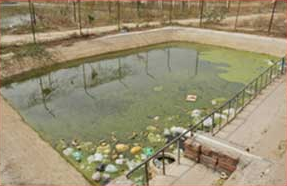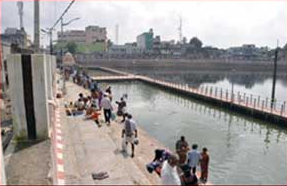Main Temple Renovation
As per Endowment requirement the main temple renovation should be done once in twelve years. Earlier one was done in the
year 1998 and the previous one as early as 1958. The initial study revealed that major restoration work was
expected. The management prepared for something challenging and tough. Appropriate methods, technical expertise
and services of varied artisans who have special skills and training were invited to form a expert team.
Renovation of all the Gopuram at the entrance and also inside the temple: There are eight Gopurams including
the main Five-storied Gopuram and seven over the sannidhies inside. Estimates have been received from reputed
Sthapathies. The best among them is selected.
FRESH LAYERS OF WEATHERING COURSE:
There are about 40,000 sft of roofing over the mantapams & various sannidhis. These are over the vahana mandapam, yagasalai, Ramanujar Sannidhi, Andal Sannidhi Desikar Sannidhi, Venugopalan Sannidhi, Ramar Sannidhi, Alvar sannidhi, kitchen etc. During heavy rains, profuse leakages were found from these roofings. Since the existing weathering course is ancient, with heavy thickness of layers and liners. many experts were consulted for a suitable solution. Finally a procedure generally as per the following specification was finalised and the initial work has been completed.
A. Application of 3 mm thick APP membrane including primer over roof slab.
B. Laying 12 mm thick cement mortar plaster.
C. Application of Extruded Polystyrene Thermal Insulation over roof slab for roof water proofing works.
D. Final laying of Kerala tiles with cement concrete layer underneath. After scrutiny of sufficient rates
the best of contractor is fixed, each for first stage and the final tile laying.
LAYER OF KERALA TILES OVER COARSE CONCRETE LAYER
While executing the work care was taken to relocate the rain water drains at a higher level for easy flow. The existing slope was not hanged as it was found satisfactory. The structure of old course was not disturbed, considering the legacy of such construction.
RAIN WATER HARVESTING
There is presently a system to carry part of the rain water into the tank which has been blocked. There are fresh reminders
from the Tamil Nadu Government for installation of an effective rain water harvesting system. Since we have
two wells within the premises of the temple, it is also required to harvest the rainwater from within the
temple area. During heavy rains, the entire water from the roof flows on the prakarams and stagnates due
to improper draining systems. Hence an effective system has been designed and executed.
Six wells of four feet diameter and 12 feet depth were first sunk. From the bottom of the each well, slotted
pipes of 6” diameter were sunk for further depth of 25 feet. Finally the wells were filled with 2 inches
gravel for a depth of nine feet. Then the wells were closed with steel plates.
The complete collection of rain water from the roof tops are directed to these wells by gutters and PVC
pipes, embedded below the cut-stone flooring over the prakarams. During recent rain, the harvesting was found
to be satisfactory.
Neerazhi Mantapam
There is a structure known as a Neerazhi Mandapam situated in the centre of the tank. This Mantapam is dedicated to Sri Veeraraghava
Swamy. The main purpose is to house the deity during the Float Festival.. It is constructed with granite
stone. With the permission and blessings of Srimad Azhagiyasingar, the hereditary trustee of the Devasthanam,
the Mantapam went through extensive renovation and cleaning as part of renovation of the Tank and the temple.
On detailed study it was found that the structure had not been repaired. or decades, except for some white
washing.
The Neerazhi Mantapam is surrounded by 90 Ft X 90 Ft platform all around. Around 1972-74, at the time of
Sri Mukkur Srimad Azhagiyasingar, a tiny tank was dug at the centre of seven acre dry tank, around the Neerazhi
mantapam. At that time the dwindling structural strength of the stone structure of the neerazhai mantapam
might have been noticed. Due to some restraints, deep study was not made and a 9 inches X 3 feet high brick
belt was constructed around the base of the mantapam with the intention of strengthening the structur e.
Presently this belt had separated from the stone structure and thick vegetarions have grown which were deeply
rooted. Also the stone layer on the mantapam floor was not packed leak proof. Due to battering of weather
the water had been seeping into the structure and washing away substantial amount of sandy bottom. This in
turn has shaken the foundation of the stone pillars and they started very slowing drifting.
All these are finding of the experts from archeology, L & T and Public Works Department. Under their advice
and supervision extensive corrective steps were taken with modern technology and at the same time not spoiling
the traditional construction
KSHETHIRA DETAILS/FEATURES
| Kshethram | Punyaavartham |
| Aranyam (Forest) | Veeksharanyam |
| Vimanam | Vijayakoti Vimanam |
| Theertham | Hrith-thapa-Nasini Pushkarani |
| Perumal Thirunamam | Sri Evvulkidanthan, Sri Veeraraghavan |
| Thirukolam | Bujangasayanam |
| Prathyaksham | Sri Salihothra Maharishi |
| ThayarThirunanam | Sri Kanakavalli/Sri Vasumathi |
| Mangalaasasanam | Thirumazhisai Azhwar &Panchakam |
| Thirumangai Azhwar | Swami Vedantha Desikan |
| Verses in Praise | Vadalur Ramalinga Adikalar |
Nanthavanam
Padasalai
TEMPLE TANK RENOVATION AND RESTORATION
At Thiruvallur Sri Veeraraghava swamy Devasthanam the temple and tank are inseparable. The tank is an important site for cultural and religious activities. Earlier years the Temple tank was rehabilated by rainwater harvesting in. In turn the tank water recharges helps the groundwater recharge. Temple tanks occupy a prime position in the day to day living of the people. Water storage has been dry in the Veeraraghavaswamy Temple tank for the past more than four decades due to rapid urbanization and continuous withdrawal of groundwater.
More than the sanctity of the holy water, the surface area of SVD tank is seven acres. The tank has been dry during recent decades due to urbanization, continuous withdrawal of groundwater and blockage of inlet systems, due to mushrooming of commercial and residential apartments in the catchment areas.
The management approached Indian Institute of Technology to get suggestions regarding methods to improve their storage potential., Renovation commenced in 2014 with their technical support . The tank bed was covered with alluvial clay to a depth 600 mm (two feet). Deep bore wells were sunk at the tank. Due to unprecedented floods, the tank was filled with abundant water.





















